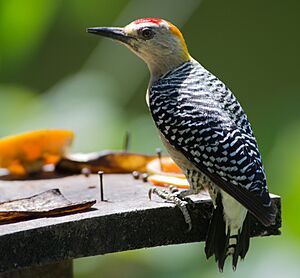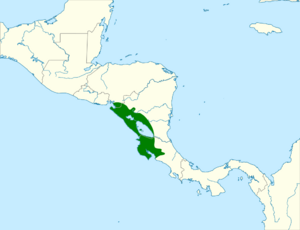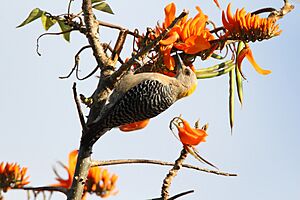Hoffmann's woodpecker facts for kids
Quick facts for kids Hoffmann's woodpecker |
|
|---|---|
 |
|
| Conservation status | |
| Scientific classification | |
| Genus: |
Melanerpes
|
| Species: |
hoffmannii
|
 |
|
The Hoffmann's woodpecker (Melanerpes hoffmannii) is a type of bird that belongs to the woodpecker family. You can find this colorful bird in Central America, from Honduras all the way south to Costa Rica.
Contents
About the Hoffmann's Woodpecker
The Hoffmann's woodpecker is a unique bird. It was named after a German scientist named Karl Hoffmann. Sometimes, people thought it was a subspecies of the golden-fronted woodpecker. These two types of woodpeckers can even have babies together where their homes meet! The Hoffmann's woodpecker can also mix with the red-crowned woodpecker in the southern parts of its range.
What Does Hoffmann's Woodpecker Look Like?
This woodpecker is about 18 to 21 centimeters (7 to 8 inches) long. It weighs between 62 and 84 grams (2.2 to 3 ounces). Both male and female Hoffmann's woodpeckers look very similar. However, their heads have different patterns.
- Males: They have a dull white forehead and a bright red crown on top of their head. Their neck is bright yellow or orange.
- Females: They have a dull white crown and a pale yellow neck.
Both male and female woodpeckers have yellowish-gray faces and throats. Their backs are striped with black and white. Their lower back is plain white. Their wings are black with white stripes and spots. Their tail is black with some white. Their chest is a dull grayish-white, and their belly is bright yellow. Their sides and under their tail are yellowish-white with black stripes. They have a black beak, hazel eyes, and bluish-gray legs.
Where Do Hoffmann's Woodpeckers Live?
You can find Hoffmann's woodpeckers in southwestern Honduras, through Nicaragua, and into central Costa Rica. There has even been one sighting in El Salvador. These birds like to live in dry forests and areas where trees lose their leaves. They also enjoy more open spaces. This includes coffee farms, city parks, and even gardens around houses. They can live from sea level up to about 400 meters (1,300 feet) in Honduras. In Nicaragua, they go up to 800 meters (2,600 feet). In Costa Rica, they can be found at heights of over 2,100 meters (6,900 feet)!
Hoffmann's Woodpecker Behavior
Movement and Daily Life
Hoffmann's woodpeckers stay in the same area all year long. They do not migrate to different places.
What Do Hoffmann's Woodpeckers Eat?
These woodpeckers usually look for food from the bottom of the forest up to the tops of the trees. Sometimes, they even search for food on the ground! Their main diet is small insects and spiders. They find these by digging into old tree trunks and branches. They also eat many different kinds of fruits. Sometimes, they drink nectar from large flowers. Occasionally, they might even eat the eggs of other birds.
Reproduction and Life Cycle
Hoffmann's woodpeckers usually breed from January to July. They often raise two sets of babies during this time. Both the male and female woodpeckers work together to dig out a nest. They make their nests in soft, dead wood, living palm trees, or even fence posts. The nest hole is usually about 1 to 6 meters (3 to 20 feet) above the ground. Both parents protect their nest very strongly from other woodpeckers and other birds like tityras. A female woodpecker usually lays two or three eggs. Both parents take turns sitting on the eggs to keep them warm. They also both feed the baby birds once they hatch. We don't know exactly how long it takes for the eggs to hatch or for the babies to leave the nest.
Sounds and Calls
The most common sound a Hoffmann's woodpecker makes is a "churrr" call. Both males and females make this sound. They also make a questioning, scratchy sound like "woick-a woick-a woick-a.." or "wicka wicka wicka." These woodpeckers usually drum on dead wood. However, they have also been seen drumming on metal objects!
Hoffmann's Woodpecker Status
The IUCN (International Union for Conservation of Nature) says that Hoffmann's woodpecker is a species of "Least Concern." This means they are not currently in danger of disappearing. They live in a very large area. Scientists believe there are at least 50,000 adult birds, and their numbers seem to be growing. There are no immediate threats to this species. In fact, they have spread to new areas recently. This is partly because of deforestation, which creates more open spaces they like. However, removing dead trees can be bad for them. This is because dead trees are where they like to build their nests.



